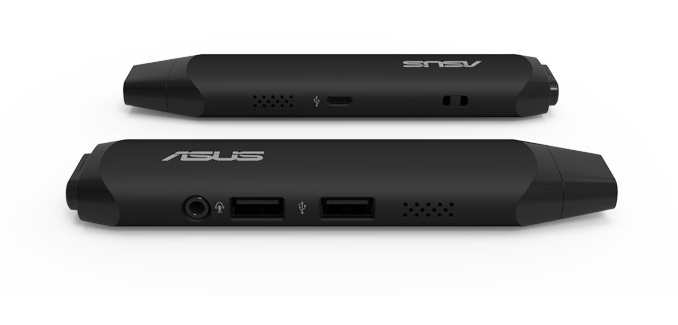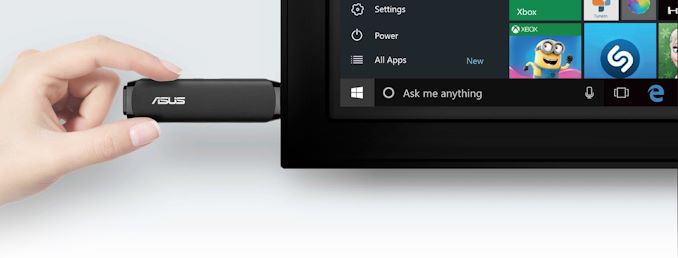ASUS Upgrades Compute Stick: The VivoStick TS10 Gets More RAM, Storage, & Windows 10 Pro
by Anton Shilov on February 19, 2020 7:00 PM EST- Posted in
- Desktop
- Systems
- Atom
- Asus
- Cherry Trail
- Compute Stick
- VivoStick

Intel’s Compute Stick, a self-contained PC-on-a-stick that could be used to transform any display into a PC, was an interesting concept when it was revealed several years ago. However it never really took off in the intervening years, due in part to limitations imposed by the form factor, leading to the chipmaker to abandon the project. Still, the Compute Stick did find a small but apparently loyal user base who remained interested in the niche solution, and so this week ASUS is introducing a new version of its VivoStick PC TS10 with more RAM and Windows 10 Pro.
First introduced back in 2017, the original ASUS VivoStick PC TS10 was based on Intel’s Atom x5-Z8350 SoC (Cherry Trail with 4 Airmont CPU cores), which was accompanied by 2 GB of LPDDR3-1600 memory as well as 32 GB of eMMC storage. The newly updated VivoStick PC TS10, model TS10-B174D, sticks with the same chassis and uses the same SoC, but it is now equipped with 4 GB of LPDDR3 memory as well as 64 GB of storage. Furthermore, the new unit also runs Microsoft’s Windows 10 Pro, replacing Windows 10 Home used in the original model.
Otherwise, the VivoStick is essentially unchanged from its earlier incarnation. The unit has two USB Type-A ports (2.0 & 3.0), a Micro USB connector for power, an combo audio jack, and an HDMI 1.4 connector for video out.
The original VivoStick TS10 with Windows 10 Home was designed primarily with consumer and SOHO applications in mind, and many retailers still sell it as a media streaming player that offers Windows 10 flexibility and can run loads of applications. But with the updated VivoStick TS10, ASUS seems to be broadening their niche just a bit, especially with access to Pro-focused features like Active Directory support and Microsoft Update for Business. Potentially, this means that ASUS can position the new VivoStick PCs differently and aim customers who need cheap miniature computers with business-class features and security.
So far, ASUS has introduced its revamped VivoStick PC TS10 in Japan and has not disclosed its pricing. All told, it is pretty strange for a PC maker to introduce an improved version of a three-year old product, so it will be interesting to see just what ASUS has in mind for their updated compute stick.
Related Reading:
- The Intel Compute Stick (Core m3-6Y30) Review
- The Intel Compute Stick (Cherry Trail) Review
- Intel Expands Compute Stick Family with Cherry Trail and Core M Models
Source: ASUS Japan (via Hermitage Akihabara)











35 Comments
View All Comments
p1esk - Wednesday, February 19, 2020 - link
I had a stick PC with that Atom processor. It's crap.deil - Thursday, February 20, 2020 - link
what did you expect from 1W cpu? its powered with less than your phone.nandnandnand - Thursday, February 20, 2020 - link
Atom x5-Z8350 is listed as 2W "scenario design power".Is the VivoStick "chassis" made of plastic? If so, fixing that bad design choice could boost performance, along with using Lakefield.
konbala - Thursday, February 20, 2020 - link
x7 with 4gb ram is pretty OK, had a GPD Win 1 and used it A LOT.mkozakewich - Friday, February 21, 2020 - link
It seems you need 8GB minimum, these days. I have no idea what's been going on with browsers, but mine routinely take up 4 GB with just a few tabs.Pessimism - Friday, February 21, 2020 - link
That would be JavaScript, the scourge of the modern internet, because we totally need a gigabyte of active scripting, telemetry gathering and social media connectors to display a paragraph of poorly written text fenced in by advertisements and clickbait aggregators.lmcd - Wednesday, February 19, 2020 - link
I wish there were modern variants of this form factor -- I have plenty of fun things to attach to my NexDock but something of this nature would be optimal for "pseudo-laptop" usage. The corded RPi option isn't great for on-lap usage without adhesives.Kakti - Wednesday, February 19, 2020 - link
"Are you sick having hair on your head? Does it get in your eyes, and keep your head warm? Introducing s a solution to all your problems: The Asus Vivostick TS10 'compute stick'. We guarantee that within 3 weeks of using this product, you'll have ripped out every hair on your head in frustration. Whether it's the slow eMMC storage or the complete lack of available RAM, this thing is sure to make your blood pressure skyrocket and give you heartburn. If you're looking to go bald ASAP and possibly have a heart attack, we've got the product for you!"just4U - Thursday, February 20, 2020 - link
I got a laugh out of that!azazel1024 - Thursday, February 20, 2020 - link
I agree that it needs a newer SOC. However, I have the same SOC in my Asus T100ha, including 4GB of RAM and 64GB eMMC. It sure as heck isn't blazing fast, but it works okay. I am looking at a full up 11.6 or 13" 2-in-1 to replace it, but that is as much about desiring a larger screen than anything. That and they keep getting thinner and lighter, so most of the nicer 11.6 and 13" 2-in-1 don't weigh much more than my 10.1" T100ha.It is NOT blazing fast, but the experience in most of Windows is fine.
My biggest concern as a media streamer is that there is no h265 hardware acceleration. My T100ha does okay with 1080p h.265 with even reasonably demanding settings. However it CANNOT do 4k. Full stop. And with 1080p h.265 decoding it is humming along at around 60% CPU load. 1080p h.264, which does have hardware decode support it ticks over at around 15% CPU load.
So using this for a 4K display/TV would be disappointing at best since the GPU can't support that resolution as well as not having the muscle to decode it (I've tried 4K h.265 decodes just to the 720p display on my T100ha and it just won't do it.
So I can see where this could have a place, especially if you wanted a tiny footprint file server or something (connected to USB storage), maybe a network firewall. As a media streamer, the fact that it lacks hardware h.265 decode as well as 4k support leaves it flat.